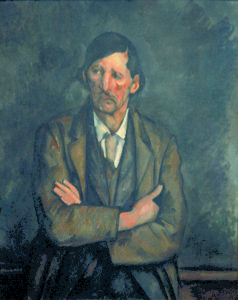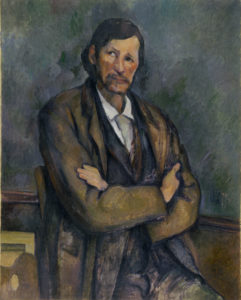R851 – L’Homme aux bras croisés, vers 1899 (FWN528)
R850 – L’Homme aux bras croisés, vers 1899 (FWN527)
Pavel Machotka
(Cliquer sur l’image pour l’agrandir)
It is physical vitality that animates this portrait of a man with crossed arms; he looks to his right, and his gaze follows the pronounced slant of his head and body toward the upper corner. In the painting studied here (R851-FWN528), the body is turned clockwise from the viewer and the slant of the eyes is very pronounced; this requires a few items (from the artist’s paraphernalia, it turns out) to pull the lower left corner down. We seen a similar elongation of the head in earlier portraits (Portrait d’Antony Valabrègue), but here the distortion is more radical; the mouth and the chin follow, as do the shoulders and the wainscotting. I think we may assume that the sitter’s face was somewhat asymmetrical and that Cézanne made the most of it, stretching it beyond its real appearance and producing a painting of uncommon authority. In spite of the deformation, the painting is balanced and well anchored; this is because the stretching is confined to the part above the hands (except for the wainscotting). This portrait, then, is a study of a man’s character as expressed in his physiognomy; it is also very physical, with all the parts of the figure modeled as if for a sculpture and rimmed with bulky, repetitive outlines. As with other asymmetrical portraits, a glance at the painting in a mirror will reveal the full extent of the distortion.
Source: Machotka, Cézanne: the Eye and the Mind.



